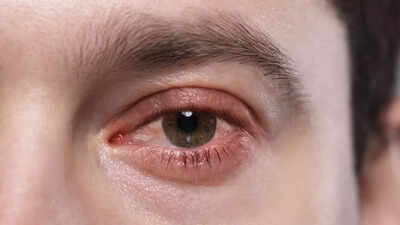ARTICLE AD BOX

Delhi’s air pollution is widely known for causing respiratory and heart problems, but recent scientific evidence shows it is also harming vision. The eyes are directly exposed to pollutants, making them especially vulnerable to damage from fine particles and toxic gases.
Over the past few years, doctors have reported a growing number of eye disorders linked to poor air quality. A national study published in Scientific Reports found a clear connection between fine particulate matter (PM2.5) and eye disease across India, with Delhi among the worst-affected regions. The findings reveal that toxic air is not just a breathing hazard but it is also silently affecting eye health, an aspect that has long been overlooked.
How air pollution damages the eyes
The surface of the eye, which includes the cornea, conjunctiva, and tear film, is constantly exposed to the outside environment.
Pollutants such as nitrogen oxides, sulphur dioxide, and especially fine particles smaller than 2.5 micrometres (PM2.5) can cause irritation and long-term inflammation. Research published in JAMA Ophthalmology and Environmental Health Perspectives shows that exposure to these pollutants can reduce tear quality, damage corneal cells, and lead to conditions like dry eye syndrome and allergic conjunctivitis.
Long-term exposure also increases the risk of cataracts. In Delhi, where PM2.5 levels often rise above 200 µg/m³ in winter, many people report persistent eye redness, itching, and discomfort which are signs that the city’s air is affecting vision as much as it affects breathing.
What the new study reveals about India’s eye health crisis
A 2024 study published in Scientific Reports examined over 32 million eye-related hospital records across India from 2019–2020 and matched them with NASA’s PM2.5 emission data.
The researchers found a strong positive correlation (r = 0.54, P < 0.001) between particulate emissions and eye disease. Rural India accounted for nearly 80% of these cases, though Delhi ranked among the highest districts overall. The study identified emissions from cooking fuels, incense burning, and transportation as the main sources linked to higher disease rates.
Weather factors like humidity and rainfall showed little effect.
The findings indicate that PM2.5 exposure doesn’t just cause temporary irritation, it may promote chronic inflammation that increases the risk of serious eye disorders.
Delhi’s eye problems under a cloud of smog
Delhi’s severe winter smog, caused by temperature inversions, vehicle emissions, and crop burning, traps fine particulates close to the ground. During this season, doctors report more patients with eye irritation, burning, and watering. Research in The Lancet Planetary Health notes that high PM2.5 levels can accelerate degenerative eye conditions, including glaucoma and corneal opacity.
Delhi’s air pollution often exceeds the national safety limit of 40 µg/m³, leaving residents exposed to levels many times higher.
The mix of exhaust fumes, industrial smoke, and domestic emissions creates a toxic combination that harms eye tissues. These overlapping pollutants make Delhi’s situation worse than that of many other cities with similar pollution levels.
The hidden burden in rural areas and among women
While Delhi’s smog draws attention, rural India faces its own crisis.
The Scientific Reports study found that people living in polluted rural areas are four times more likely to develop eye diseases than those in cleaner regions. This is mostly due to cooking with biomass fuels such as firewood and cow dung, as well as indoor smoke from burning incense or mosquito coils. Women are especially affected because they spend more time near household smoke sources.
Research in BMJ Open and Environmental Research supports this, showing that long-term exposure to biomass smoke doubles or triples the risk of cataracts.
Urban residents, in contrast, benefit from cleaner fuels and easier access to medical care. The findings show that both environmental and social factors play a role in how pollution harms vision.
Why eye health needs to be part of air quality policy
The link between PM2.5 and eye disease has serious implications for public health. Eye problems caused by air pollution can lower productivity, affect education, and increase healthcare costs. Experts at the Indian Council of Medical Research (ICMR) recommend that eye health indicators be included in national air quality monitoring systems.
Recent laboratory research published in Nature Communications found that ultrafine particles can penetrate the cornea and damage DNA, increasing the risk of chronic eye disorders.
In Delhi, some preventive measures, such as indoor air purifiers and protective glasses, help reduce irritation, but they only offer temporary relief. Reducing emissions from vehicles, household fuels, and waste burning remains essential to protect vision and overall health in polluted cities.
Preventing pollution-linked eye damage: What can be done
While long-term solutions depend on cleaner air policies, individuals can take several steps to protect their eyes from pollution-related harm. Eye specialists recommend the following preventive practices:
- Protective eyewear: Use wraparound sunglasses or pollution goggles when outdoors, especially during high-smog days, to reduce direct contact with airborne particles.
- Frequent rinsing: Wash eyes with clean water or saline solution to remove dust and particulate deposits.
- Maintain hydration: Drinking sufficient water and using preservative-free lubricating eye drops can help keep the ocular surface moist.
- Avoid outdoor exposure during peak pollution hours: Early mornings and late evenings, particularly in winter, tend to have the highest PM2.5 concentrations.
- Indoor air improvement: Using air purifiers and reducing indoor smoke from incense, candles, and cooking fuels can lower overall exposure.
- Regular eye check-ups: Periodic eye examinations allow early detection of dry eye symptoms, inflammation, or other pollution-related issues.
Public awareness campaigns that highlight these preventive steps, alongside stronger emission control and air-quality monitoring, can play a key role in reducing the rising burden of eye diseases in polluted cities like Delhi.Disclaimer: The information provided herein is for educational and informational purposes only and does not constitute medical advice, diagnosis, or treatment.Also Read | Just 5 minutes can reset your brain: What scientists found about micro-breaks

 5 days ago
7
5 days ago
7








 English (US) ·
English (US) ·